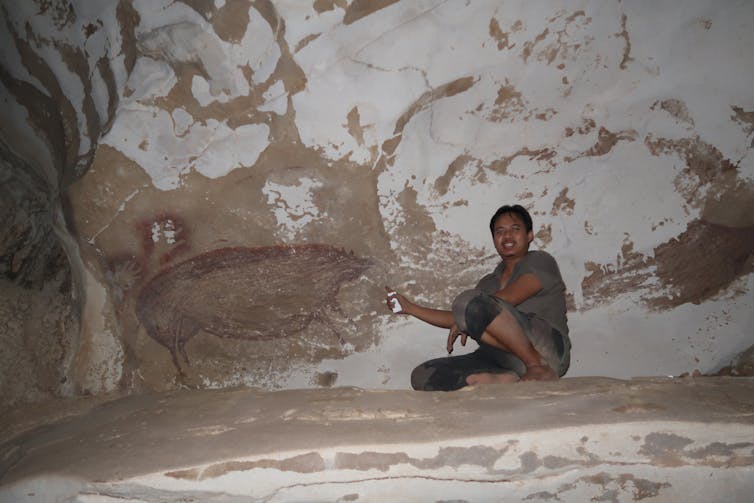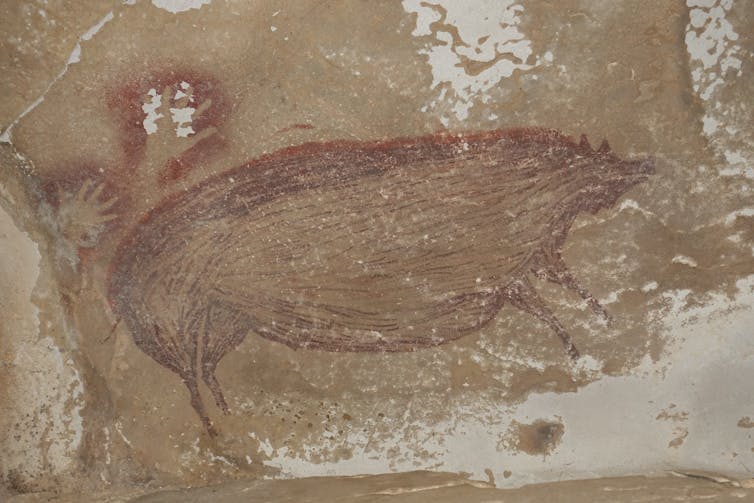We found the oldest known cave painting of animals in a secret Indonesian valley
- Written by Adam Brumm, Professor, Griffith University
The dating of an exceptionally old cave painting of animals that was found recently on the Indonesian island of Sulawesi is reported in our paper out today.
The painting portrays images of the Sulawesi warty pig (Sus celebensis), which is a small (40-85kg) short-legged wild boar endemic to the island.
Dating to at least 45,500 years ago, this cave painting may be the oldest depiction of the animal world, and possibly the earliest figurative art (an image that resembles the thing it is intended to represent), yet uncovered.
Oldest cave art found in Sulawesi.Ice age art in Indonesia
Sulawesi is host to abundant cave art, the existence of which was first reported in the 1950s.
Read more: Indonesian cave paintings show the dawn of imaginative art and human spiritual belief
Until recently, the prevailing view was this art was the handiwork of Neolithic farmers who arrived around 4,000 years ago from southern China rather than the hunter-gatherers who had lived on Sulawesi for tens of thousands of years.
We now know that this is not correct.
In 2014, we reported the first dates for the South Sulawesi rock art.
Based on uranium-series analysis of mineral deposits (calcite) that formed naturally on the art we showed that a stencilled image of a human hand found in one cave was created at least 40,000 years ago. This is compatible in age with the famous ice age cave art in Europe.
Ice age art in the tropics.Then, in 2019, we dated a spectacular painting at another cave that portrays hybrid human-animal figures hunting Sulawesi warty pigs and dwarf buffalos (anoas). This hunting scene is at least 43,900 years old and it features what may be the oldest depictions of supernatural beings.
Earliest hunting scene in prehistoric art.In our latest study we push the age of Sulawesi’s rock art a little deeper into the past.
The secret valley
In December 2017 we conducted the first survey of an isolated valley set in mountainous terrain a stone’s throw from one of Indonesia’s largest cities, Makassar.
 The limestone karst valley in which Leang Tedongnge is located.
David P McGahan, Author provided
The limestone karst valley in which Leang Tedongnge is located.
David P McGahan, Author provided
Despite its proximity to a major urban centre, there is no road to this valley. The small community of local Bugis farmers live a secluded existence, although they are widely reputed for the sublime quality (and potency) of their palm wine (ballo).
According to them no Westerner had ever set foot in their valley before.
This secret valley is a pristine environment and a place of resplendent natural beauty. There is hardly any rubbish in the tiny village in the centre of the valley. Being there feels like stepping back in time.
The valley harbours a limestone cave known as Leang Tedongnge and inside it we found a rock painting the locals claimed they had never noticed before.
 Adhi Agus Oktaviana in front of the Leang Tedongnge rock art panel.
Adhi Agus Oktaviana, Author provided
Adhi Agus Oktaviana in front of the Leang Tedongnge rock art panel.
Adhi Agus Oktaviana, Author provided
The painting was produced using a red mineral pigment (ironstone haematite, or ochre). It depicts at least three Sulawesi warty pigs engaged in social interaction of some kind.
We interpret the surviving elements of this artwork as a single narrative composition or scene, a mainstay of how we tell stories using images today but an uncommon feature of early cave art.
 The top image has been enhanced (in DStretch) to make the artwork clearer. The bottom image shows a tracing of the art.
Adhi Agus Oktaviana, Author provided
The top image has been enhanced (in DStretch) to make the artwork clearer. The bottom image shows a tracing of the art.
Adhi Agus Oktaviana, Author provided
Unlocking the age of the art
Dating rock art is very difficult at the best of times. But at Leang Tedongnge we were fortunate to identify a small calcite deposit (known as “cave popcorn”) that had formed on top of one of the pig figures (pig 1).
We sampled the calcite and analysed it for uranium-series dating. Amazingly, the dating work returned an age of 45,500 years ago for the calcite, meaning the painting on which it formed must be at least this old.
 A close up of the dated warty pig painting at Leang Tedongnge.
Maxime Aubert, Author provided
A close up of the dated warty pig painting at Leang Tedongnge.
Maxime Aubert, Author provided
Early art in Wallacea
Our discovery underlines the global importance of Sulawesi, and the wider Indonesian region, for our understanding of where and when the first cave art traditions developed by our species arose.
The great antiquity of this artwork also offers hints at the potential for other significant findings in this part of the world.
Sulawesi is the largest island in Wallacea, the zone of oceanic islands located between mainland Asia and the ice age continental landmass of Australia-New Guinea.
Read more: First pocket-sized artworks from Ice Age Indonesia show humanity's ancient drive to decorate
Modern humans are said to have crossed through Wallacea by watercraft at least 65,000 years ago in order to reach Australia by that time.
But the Wallacean islands are poorly explored and presently the earliest excavated archaeological evidence from this region is much younger.
We believe further research will uncover much older rock art in Sulawesi or on other Wallacean islands, dating back at least 65,000 years and possibly earlier.
Authors: Adam Brumm, Professor, Griffith University





